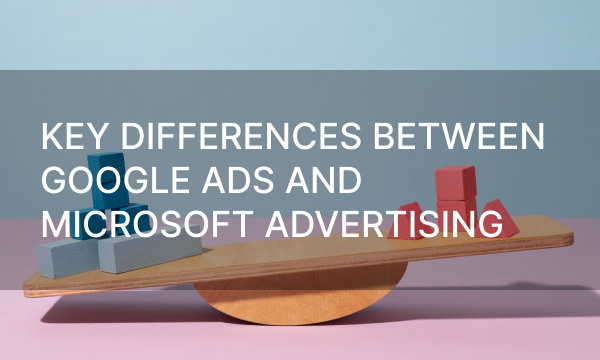Briefly about the importance of understanding the differences between Search Ads and Display Ads.
In today’s world of online marketing, there are various types of digital advertising to promote your business. When planning an advertising campaign, you may hesitate choosing between Search Ads vs Display Ads. A lot depends on the choice you make. Choosing the wrong format will not produce the desired results, while choosing the right one will increase the conversion rate of your business. Therefore, when choosing between these two formats, it is extremely important for you to understand their differences.
To begin with, search advertising and display advertising serve different promotional purposes. Search Ads target users with strong intent and high conversion rates who are actively looking for products and services. Display Ads through creative visuals on websites increase brand awareness and reach a wider audience.
But how to understand which advertising format is better for you? What is the difference? How to use both Search Ads and Display Ads to maximize your ROI? In this article, we’ll answer these important questions and highlight everything you need to know about using Display Ads vs Search Ads for your business.
Search Ads and How It Works
 Photo by Arkan Perdana on Unsplash
Photo by Arkan Perdana on Unsplash
Paid search advertising is the most popular form of PPC ads. Brands pay on an auction-based model to have their ads displayed above and below organic search engine results when users search for certain keywords. Search Ads must have a title, a display URL, and a description to convince the users to click the link. Ad extensions can provide users with additional information. Search Ads frequency, ranking, and cost-per-click are affected by the bid and quality score.
The way Search Ads work is simple. When a user within your target audience searches for a keyword you’ve bid on, the search query will trigger your ad and it will appear in the ads section of the search results page. The advantage here is being able to compete with larger brands without spending huge amounts of money on advertising. Business owners can target searchers based on their geolocation.
Search Ads are based on the following principles:
- Limiting search engine results. Advertisers select relevant keywords and bid to ensure their ads appear when searched for.
- Bidding process to determine ads that appear on SERP. Search queries with the highest bids have a chance of showing up in the best ad positions. Google Ads charges you when someone clicks on your ad, following a pay-per-click model.
- Reaching a targeted audience and paying only for engaged clicks. Selecting and bidding wisely requires a clear understanding of your audience and of your chosen platform.
- Increasing search engine traffic with SEO. Optimizing your website’s content helps improve your website’s ranking in organic search results, driving more traffic without spending extra on advertising.
Advantages of Search Ads
- Budget control: Search Ads help companies with a modest monthly budget control targeting and timing.
- Targeted keywords: Focusing on specific keywords attracts users who are actively searching for your product or service, avoiding wasting ad spend on uninterested people.
- Local market targeting: Search Ads effectively reach local markets by combining keyword targeting with geographic, language, gender, age and affinity targeting options.
- Short sales cycle: Search advertising works to attract users within the area of the purchase without requiring ongoing advertising to people who have already taken action.
- Remarketing flexibility: While remarketing is a powerful tool, it is not essential for all businesses in Search ads, providing fresh and adaptable audience targeting.
Display Ads and How They Work
 Photo by Daniel Korpai on Unsplash
Photo by Daniel Korpai on Unsplash
While Display Ads are still created within the Google Ads interface, they work very differently from their paid search competitors. Display Ads aren’t limited to showing in one place, like Search Ads in the SERP. Display Ads show across the entire Google Display Network. They can display in multiple places on social media, such as news feeds or on the side of the main feed.
Display Ads are one of the ways to increase awareness of a new brand, a new product, or a new service. Otherwise known as banner advertising, it is displayed in front of your target audience every time they are browsing the Internet but not looking for the services or products you offer. User-generated content does not need to be related to your business to serve Display Ads. This is a good strategy to introduce your brand to loyal customers while they spend most of their time on websites of their interest.
Display Ads have a wider reach to appear on multiple websites across Google. This network includes millions of websites, allowing you to target specific audiences based on their interests, purchasing behavior and individual search terms. So you can use banners or text on websites to reach your prospects or even choose specific website placements that are relevant to your audience.
Google groups websites into categories and offers them as a package. Advertisers bid on placements on selected sites, with the highest bids winning. Advertisers wisely use Google remarketing to target users who have previously visited their websites. Display Ads are flexible when it comes to different sizes and images, allowing for more creative possibilities.
Advantages of Display Ads
- Display advertising has proven to be effective for visually oriented products such as clothing, cars, cosmetics and pet care products. They can be easily summarized and visually presented with a single image, making display advertising profitable.
- Display Ads are helpful for SaaS, insurance, education, or B2B services. A slightly different approach involves using short impactful phrases, key value propositions, or explanatory graphics to quickly attract users.
- Display Ads pave the way to niche or luxury buyers. Target specific websites through special platforms for a better performance. Use data mining with Display Ads to deliver your message at the right time.
- Building brand awareness with Display Ads drives top-funnel traffic and increases brand equity. Use simple slogans or images of key products that match your website’s homepage for brand awareness.
Search Ads vs Display Ads: Which are Better
 Photo by Aaron Sebastian on Unsplash
Photo by Aaron Sebastian on Unsplash
The key difference between Search Ads and Display Ads is that the first ones are pull advertising, while the second ones are push advertising. In simple terms, Search Ads are only shown to people who are already looking for your product or service, while Display Ads are paid placements that appear based on various targeting options. Both Search Ads and Display Ads are popular, but they’re built differently.
You can easily generate revenue using either Search Ads or Display Ads. But if you use both formats, you’ll get better results. By using these two ad formats together, you’ll be targeting your customers from all possible traffic sources. It will also help your audience become aware of your brand when making a purchasing decision.
Average metrics comparison
The performances of Search Ads and Display Ads can be compared by conversion rate and cost per click. The industry benchmarks for these two key metrics can vary significantly between the two types of ad campaigns. Even the highest Display Ads conversion rate can’t beat the lowest Search Ads conversion rate. Search Ads generate more conversions due to the connection in search networks between advertisers and customers actively searching for products.
Although the average conversion rate for Display Ads is lower, their average cost per click is also lower. While saving ad costs is a significant benefit for brands, it’s worth remembering that every business has its own unique goals. To make the right choice between Search Ads vs Display Ads, consider your target audience, advertising goals and the nature of your product or service. Based on the analysis of these factors and understanding the benefits of each type of advertising, you can make the right decision about when and how to use Search Ads or Display Ads.
Your PPC goals will always determine whether you should choose Search Ads or Display Ads. You must first understand the key differences between the two types of advertising so that you can easily pick the one that is better for you. It is recommended that you try both formats at the same time to determine which one is best for your business. Analysis of the results will give a clear picture and make it easier to make the decision.
Google recommends running both Search Ads and Display Ads for maximum reach, but this isn’t always effective. To be honest, maximum audience reach is not as important as getting into the target audience. Hitting the target is the key to successful advertising. Target those who are most likely to be interested in your product or service.
When to choose Search Ads
For businesses looking to reap the rewards right away, Search Ads offer faster impact compared to SEO. Thus, Search Ads are an effective short-term strategy that simultaneously builds supplement organic traffic for a brand presence. They allow you to use various keyword match types to trigger your advertising and get high-quality leads. Using negative keywords prevents your ad from appearing when users search for irrelevant terms. High accuracy allows you to tailor your ads to the specific search intent of users.
Search Ads are a better choice for businesses with local services that target a nearby audience. For businesses with a small target audience and a specific niche, trying to reach a global audience with Display Ads is useless. Search Ads are good for products or services with short sales cycles. So you don’t have to show ads again to the customers who are already interested in your brand.
Search Ads are also a great choice for professionals with services that are often needed at short notice, such as locksmiths, tow trucks or electricians. Typically, these services are in demand in critical situations, so customers are more likely to seek immediate support rather than view Display Ads while browsing articles or social media. Keep in mind that people are more likely to search for services of that kind from their mobile devices. Therefore, make Search Ads mobile friendly and use phone numbers in your advertising for a quick contact.
When to choose Display Ads
When it comes to Display Ads, they are great at showing visual content like images and videos. This feature makes them indispensable for promoting products and services in industries such as clothing retailing, home decor, travel and entertainment. In addition, Display Ads have a high impact when combined with visual digital assets such as videos, e-books, infographics and more.
When customers see Display Ads while browsing websites, they are likely at the bottom of the marketing funnel, researching information without active intent to purchase. The display network effectively generates demand for your product or service, causing a desire or need to purchase, even if customers are not aware of it yet. Unlike the Search Ads that meet an existing demand, Display Ads develop interest and desire. Also they are good for businesses that offer a product or service with a longer sales cycle and are not typically purchased immediately.
Display Ads increase brand awareness by appearing on websites that your prospects are already interacting with. With 2 million websites in the Google network, your ads are matched to relevant web pages based on your keywords. As a result, you can target niche audiences with interest-based advertising.
Conclusion
In conclusion, choosing between Search Ads and Display Ads depends on the specific goals and target audience of your campaign. Neither type of advertising should be underestimated. Both advertising formats have their own benefits and can be extremely effective in different situations. However, you should feel the difference in order to understand exactly when to use one or the other ad type. Once you’ve decided on your ad format and run it, it’s important to link it to relevant landing pages which lead to high conversions.
For beginners or those on a limited budget, it is recommended to use Search Ads. Here you can choose pay per click to align your budget with your goals. Bidding on relevant keywords gives you more control over reaching your target audience. This results in more leads, higher conversion rates, and better ROI. After mastering Search Ads, you can move on to Display Ads for broader reach.
To ensure your brand dominates the decision-making process of potential customers, use successful digital advertising strategies. Display Ads work well across different devices and digital marketing channels. They show ads to customers who have already interacted with your brand, even after they left your website.


